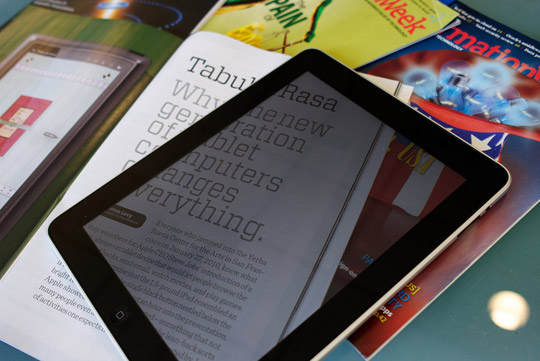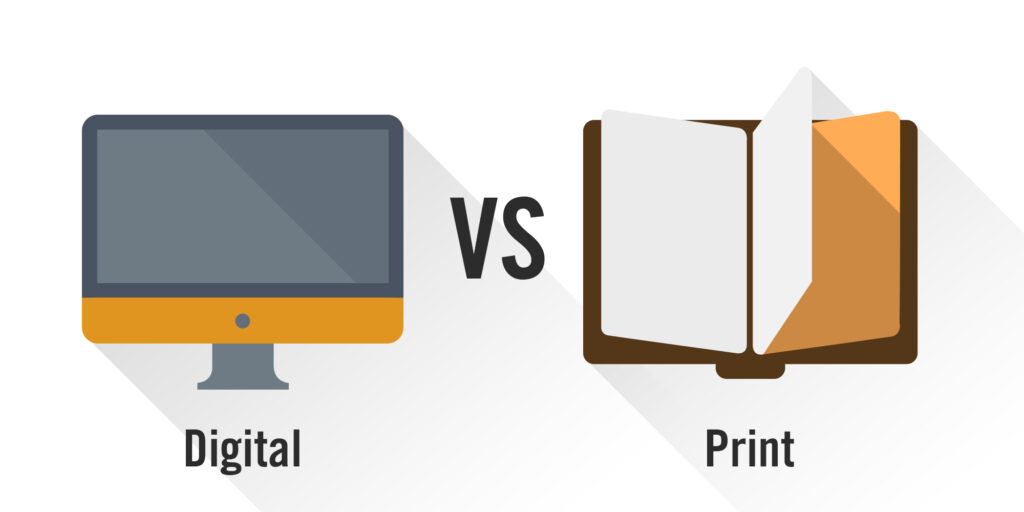General Printing News
Which is better – digital or print textbooks?
In most cases, schools and universities are still using print textbooks for courses—though iPads, laptops, and digital resources have become significantly more common in the classroom in the past 10 years. Some studies have indicated that reading in print leads to better recall and superior performance on tests, hence the enduring popularity of print textbooks among educators.

Digital Features
On the other hand, the digital format delivers benefits over the print textbook industry (and for students and school districts) that print could never offer. It can easily be updated, cutting down on the need to print new editions every few years. It can be accessed from anywhere, rendering the “I forgot the book in my locker” excuse moot. It eliminates the need to carry around heavy books, rescuing backpacks (and students’ shoulders) from undue strain. It should cost less, saving students or school districts significant sums of money, depending on who is covering the costs.
Finally, digital offers the opportunity to enrich the reading and learning experience with other media: links to websites; videos; high-quality images; interactive content like quizzes or games. These features can be built into digital texts—either directly into the book or in the form of links—and can push students to engage with the material in new and beneficial ways.

A new textbook is bridging the gap between these two formats, combining the best things about print and digital into a single product. Depending on the reception, the book could be a harbinger for what’s to come in the textbook market.
Fittingly, the book in question, titled Introduction to Graphic Communications, is about the “art, science, and business” of print media. The book, written by Dr. Harvey Levenson and John Parsons, is in its second edition, which means its lessons on print technology and “graphic communication” have already made their way into the classroom. What’s different about edition number two, though, is its innovative embrace of interactive content.

How can a print textbook be interactive?
The key is a partnership with Ricoh USA, Inc., the company behind a technology called “Clickable Paper.” Clickable Paper is an augmented reality tool that builds interactive content into print books. The apps—free to download for both the Apple iOS and Android mobile platforms—work almost like QR code scanners, which means readers can use their mobile devices to deepen the experience of reading the book. The difference is that Clickable Paper doesn’t need QR codes or barcodes to work. Instead, a user can just point a smartphone or tablet at a page and be immediately “immersed in a digital experience.” Authors and publishers don’t have to waste space embedding QR codes into the text of their books, because the texts tells the app what to do and where to go on its own.
The “digital experience” enabled by Clickable Paper can be just about anything: photos, videos, websites, blogs, articles, social media posts, e-commerce stores, games, challenges, quizzes, maps, surveys. The possibilities are very nearly endless. In addition, Clickable Paper makes it easy to update this content, which means it can change yearly, monthly, weekly, daily, or even hourly. Whether the author/publisher wants to add a new quiz to the book’s curriculum or needs to add an additional resource to incorporate information that has come to light since the publication of the book, Clickable Paper makes those updates seamless.

The technology behind Clickable Paper, called Ricoh Visual Search (RVS), could also go beyond the publishing industry. RVS captures an image and sends it to a server, which quickly identifies the text. The technology then serves up digital content related to the image and sends it to the user via his or her mobile device. For marketing, especially, the technology has big potential. Imagine taking a photo of a sign or a magazine advertisement and immediately being taken to a survey or a webstore linked to the content in question. QR codes already makes those quick transitions possible, but Clickable Paper does it without impairing the aesthetic design of the advertising.

Print textbooks and Digital solution?
The potential impact for publishing, though—and specifically the textbook industry—is what makes Clickable Paper most intriguing. Educators have been looking for an efficient and effective way of pairing the educational and psychological benefits of the print format with the limitless possibilities of digital. So far, there hasn’t really been a solution, which is why print textbooks still exist despite their considerable cost and clear shortcomings. Clickable Paper takes some of those big disadvantages—the inability to provide educational reinforcement through digital channels, the instant obsolescence of print for academic subjects that are constantly evolving—and provides a workable compromise.
Image sources
sociable.co
ricoh.com
rockfordcreatives.ae
